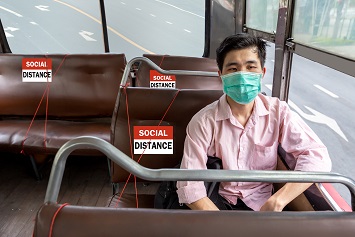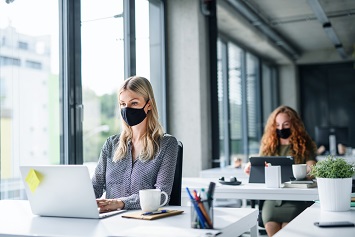There is no federal emergency temporary standard for coronavirus disease 2019 (COVID-19) exposures, and guidance from federal and state officials seems to change daily. There are a lot of decisions to make and a lot of boxes to check, with incomplete information.
The Centers for Disease Control and Prevention (CDC) and Occupational Safety and Health Administration (OSHA) don’t have definitive answers to give. Researchers in the United States and elsewhere continue to learn new information every day about the SARS-CoV-2 virus and the respiratory illness it causes.
On July 9, the World Health Organization (WHO) announced that airborne transmission of the disease in indoor spaces, especially in crowded and poorly ventilated spaces, may be possible. Airborne transmission in indoor spaces may have occurred in fitness classes and restaurants, as well as during a choir practice. However, WHO and other public health officials simply haven’t done enough research to conclude SAR-CoV-2 is “airborne.”
On July 14, CDC Director Robert R. Redfield, MD, called for the universal use of cloth face coverings in an editorial in the Journal of the American Medical Association. The CDC also reported findings of an epidemiological investigation in Springfield, Missouri: 139 clients saw two hairstylists with confirmed cases of COVID-19; clients and hairstylists all wore face masks, and no new cases were reported among the clients. The 67 clients tested for COVID-19 all tested negative.
All workers returning to the workplace should wear cloth face coverings to reduce disease transmission.
The CDC and OSHA have issued guidance on preparing workplaces for reopening and continue to update their guidance as more becomes known about the SARS-CoV-2 virus. Officials with the California Department of Public Health (CDPH) and Division of Occupational Safety and Health (Cal/OSHA) have released guidance for industries ranging from construction, grocery and retail, and manufacturing to mortuaries and funeral homes, offices, and shopping centers and malls.
Professional safety organizations like the AIHA (formerly the American Industrial Hygiene Association), the American Society of Safety Professionals (ASSP), and the National Safety Council (NSC) have compiled resources, too.
Not Reopening May Be Your Best Option
When the CDC issued guidelines for allowing workers to return to reopened offices, the NSC cautioned that “business owners should reopen when they’re ready—not necessarily because they can.” Offices and other workplaces should only reopen if employers are able to test employees and others for COVID-19 and are capable of performing contact tracing to identify employees, customers, and visitors infected in their facilities.
In the CDC’s guidelines for businesses and employers, it recommended providing telework options for employees at risk for severe illness. Older workers and workers with underlying medical conditions are or may be at risk of severe illness.
The greatest risk for severe illness from COVID-19 is among people 85 or older. However, those in their 50s are at higher risk for severe illness than people in their 40s, and people in their 60s and 70s are at higher risk for severe illness than people in their 50s.
The CDC currently warns that individuals of any age with the following conditions are at increased risk of severe illness from COVID-19:
- Chronic kidney disease;
- Chronic obstructive pulmonary disease (COPD);
- Weakened immune systems from organ transplants;
- Obesity (a body mass index (BMI) of 30 or higher);
- Serious heart conditions, such as heart failure, coronary artery disease, or cardiomyopathies;
- Sickle cell disease; and
- Type 2 diabetes.
Those with the following conditions may be at risk for severe illness:
- A blood disorder known as Thalassemia;
- Cerebrovascular disease, which affects blood vessels and blood supply to the brain;
- Cystic fibrosis;
- Hypertension (high blood pressure);
- Neurologic conditions, such as dementia;
- Liver disease;
- Moderate to severe asthma;
- Pregnancy;
- Pulmonary fibrosis (having damaged or scarred lung tissues);
- Smoking;
- Type 1 diabetes mellitus; and
- Weakened immune system from a blood or bone marrow transplant, immune deficiencies, human immunodeficiency virus (HIV), or the use of corticosteroids or other immune-weakening medicines.
Employers also should consider assigning vulnerable workers duties that minimize their contact with customers and other employees.
Adding Engineering Controls
If you must reopen your workplace and insist that workers return, you may need to make significant changes to your facility. The CDC insisted that office buildings should separate and move workstations to maintain social distancing of 6 feet between employees or install transparent shields or other physical barriers where social distancing is not an option. The CDC and OSHA recommended that meat, poultry, and seafood processing plants modify the alignment of workstations so that workers are at least 6 feet apart in all directions (both across from each other and side by side).
Meat, poultry, and seafood processing facilities also can use physical barriers like plexiglass or another material, strip curtains, or impermeable dividers or partitions to separate workers from each other.
Employers in office buildings should ensure workers maintain proper social distancing of 6 feet, even in elevators. Social distancing requirements may mean only two employees at a time can safely use an elevator. Employers also should take additional steps to ensure social distancing, such as installing additional time clocks or staggering reporting and dismissal times to prevent crowding around time clocks, reconfiguring chairs and tables in break rooms and lunchrooms, and removing communal coffee pots.
Employers also may need to make improvements to your heating, ventilation, and air conditioning (HVAC) systems to reduce the likelihood of disease transmission. The CDC recommend that office building owners and managers:
- Improve air filtration, increasing filtration as high as possible, to Minimum Efficiency Reporting Value (MERV) 13 or 14, if possible;
- Inspect filter housing and racks to ensure appropriate filter fit and check for ways to minimize filter bypass;
- Consider running HVAC systems for longer times—24 hours a day, 7 days a week, if possible—to enhance the protection offered by the two previous steps; and
- Consider using high-efficiency particulate air (HEPA) fan/filtration systems to help enhance air cleaning or ultraviolet germicidal irradiation (UVGI).
The NSC recommends additional facility upgrades for employers reopening their workplaces. Employers and building owners should consider installing hands-free arm-pull or foot-operated door openers wherever possible and installing motion-detection sensors in place of switches. They could designate separate entrances and exits for buildings and rooms and provide directional signage for traffic flow, along with physical distancing reminders or cues.
Administrative controls can also help to reduce the risks of infection. The CDC, OSHA, and others recommend frequent cleaning or disinfecting of commonly touched surfaces in the workplace. Routine cleaning of surfaces with soap and water can decrease how much of the virus is on surfaces and objects, reducing the risk of exposure.
Frequent disinfection of surfaces and objects touched by multiple people with Environmental Protection Agency (EPA)-approved disinfectants against COVID-19 (List N) also can help reduce infection risks. If EPA-approved disinfectants are not available, alternative disinfectants can be used (for example, 1/3 cup of bleach added to 1 gallon of water or 70% alcohol solutions).
 Signs, Signs, Everywhere a Sign
Signs, Signs, Everywhere a Sign
In addition to physically separating workers and installing shielding and barriers, agencies and professional groups recommend using signs and markings to encourage social distancing and hygiene practices. The NSC recommends using signage and floor markings to encourage distancing in workspaces and one-way directional flow in corridors.
Employers should instruct employees on cough and sneeze etiquette and proper hand-washing and use signs or posters in washrooms and break rooms to reinforce proper hand hygiene. To support proper hygiene, employees should be provided with an adequate number of tissues and no-touch trash cans and an adequate amount of soap and alcohol-based hand sanitizer.
Because the success of these initiatives depends largely on individual employees’ behaviors, training and communication are key to effective infection control in the workplace. During the pandemic, training should cover:
- Signs and symptoms of COVID-19 and risk factors for infection and severe illness;
- Engineering design changes in the workplace and practices and protocols put in place to prevent the spread of COVID-19, especially when employees first return to work;
- Cough and sneeze etiquette, proper hand-washing, and social distancing;
- Frequent cleaning and disinfection of commonly touched surfaces—cleaning and disinfection are everyone’s responsibility during a pandemic;
- The proper use and disposal of protective clothing and personal protective equipment (PPE), if PPE is provided;
- Procedures for reporting concerns about health and safety in the workplace and reassurances that reporting safety and health concerns will not result in retaliation; and
- Procedures for filing whistleblower complaints with OSHA or state occupational safety and health authorities if retaliation occurs.
Managers and supervisors may need additional training. Managers and supervisors, as well as peer leaders, may need to ensure cough and sneeze etiquette, hand hygiene, compliance with use of cloth face coverings, and physical distancing and recognize and respond to signs of stress and mental health emergencies.
Managers and supervisors need to understand and validate the stress and other mental health distress issues employees may be experiencing, according to the NSC. Managers, supervisors, and peer leaders also may need to utilize moderating skills and be prepared to handle sensitive topics.
They may need training on how to spot the signs of mental health issues and approaches for handling or starting a conversation with an employee who is exhibiting signs of mental health issues. Employers may want to post additional signs with information on how to contact the employee assistance program, if one exists.
As knowledge about the SAR-CoV-2 virus and the COVID-19 pandemic continues to evolve, employers should monitor established news sources for information about the virus and outbreaks and regularly check with federal, state, local, tribal, or territorial public health authorities for updated recommendations. Several research universities and teaching hospitals provide information about the virus and recommended infection control practices. The AIHA, ASSP, NSC, and other professional organizations have compiled resources for employers that they continue to update.


